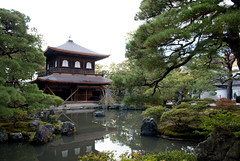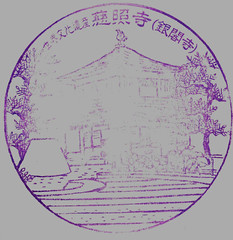 The bus dropped us off on the main road and we had to walk a few blocks to Ginkaku-ji. The sun was starting to set and a warm glow was washing over the streetscape. We bypassed all the shops on the way to the entrance to Ginkaku-ji. We got to the entrance, bought our tickets, and entered. After a twist and a turn through a corridor with bamboo walls, you come instantly face to face with the Silver Pavilion. It's actually amazing how close you actually are to the building itself.
The bus dropped us off on the main road and we had to walk a few blocks to Ginkaku-ji. The sun was starting to set and a warm glow was washing over the streetscape. We bypassed all the shops on the way to the entrance to Ginkaku-ji. We got to the entrance, bought our tickets, and entered. After a twist and a turn through a corridor with bamboo walls, you come instantly face to face with the Silver Pavilion. It's actually amazing how close you actually are to the building itself.The only bad thing during our visit that day was that the Pavilion itself was under renovation. Seeing part of Ginkaku-ji covered was simply anti-climactic. We must not have seen the signs telling us that it was under renovation. Or perhaps we had seen the sign, but it was all in Japanese and we did not take any notice of it. In any case, we had paid and we were here, so we were going to make the most of it.
The garden surrounding the pavilion is quite special. There are a few special sand gardens, called kogetsudai [高月代], that are a part of the garden. One "garden" was a giant pile of sand in the shape of an upside down cone. Another garden had been specially-raked in a pattern of alternating of even and uneven sand.
After walking the lower portion of the grounds, the sightseeing route takes you up the side of the hill and the trail then overlooks the Pavilion and the gardens below. You can also see outside of the Ginkaku-ji grounds to some of the surrounding buildings. It was almost sunset, so the sun was shining straight into our eyes as we looked westward over the grounds.
Then just as soon as we were up above the grounds, the trail took us back down and we were soon by the exit. We stopped by the gift shop and bought some bookmarks as souvenirs for some of my coworkers. That's when we discovered the first of our many stamps.
For Vancouverites, you may remember all the stamps you had to collect during Expo 86. Every single pavilion had a stamp and you would run around and try to collect as many as you can. In Japan, almost every single tourist attraction has a free stamp somewhere on the grounds. The Ginkaku-ji stamp was just outside the gift shop (and not too far from the WC). So this was our first of many stamps. Then after stamping our books, we realized that we totally forgot to look for one at Kiyomizu-dera. That was a total downer. Well, at least we got the stamp for Ginkaku-ji.
We exited the Ginkaku-ji grounds and walked back down the street towards the main road and passed many shops. Some of them were already closed for the day because it was already late in the afternoon. We walked down a little further and made a turn somewhere and stumbled across a neat little store called the Chirimen Craft Museum. We didn't know at the time, but this was one of many stores around the Kyoto area. The store sold beautiful cloth crafts of various sorts including animals, nature, and Japanese festival icons. It was a beautiful store with beautiful crafts, but if I bought something, where would I put it.
N had a hankering for walking through a Japanese supermarket. Fortunately, near the bus stop to go back to Central Kyoto, there was a supermarket. We wandered around a little and picked up some drinks. We were getting very thirsty at this point. I also bought some Kleenex because you never know when my nose is going to act up. Also, you can't always get napkins everywhere you go. Although I would say napkins are more scarce in restaurants in China and Hong Kong.
After the supermarket, we waited shortly for the bus to Central Kyoto and we were on our way again. Nightfall was definitely setting in at this point. So was the fatigue.





No comments:
Post a Comment